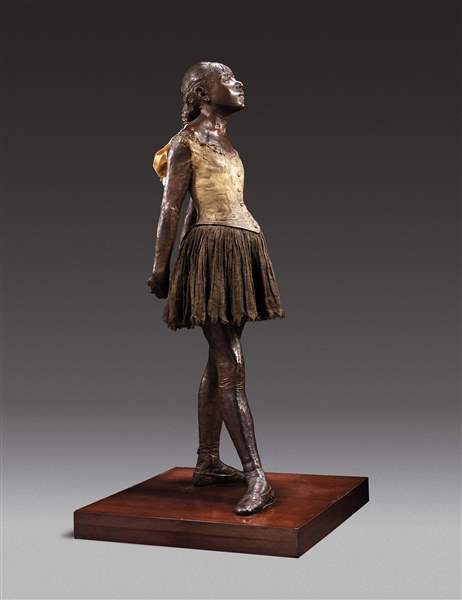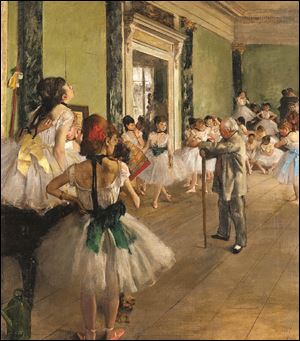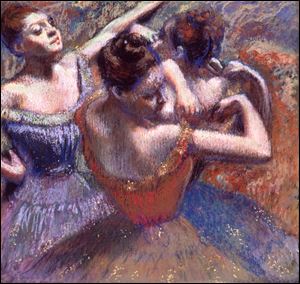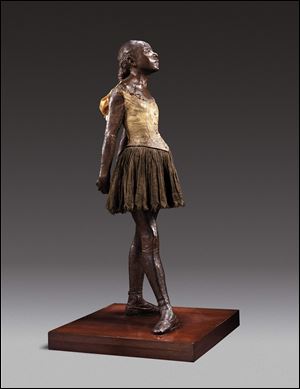
TOLEDO MUSEUM OF ART
Degas exhibit inspired by Toledo’s trailblazing ‘Nutcracker’ performance
10/11/2015
A sculpture entitled '‘Little Dancer Aged Fourteen' by Edgar Degas.
VIA BLOOMBERG NEWS
Editor's note: The Degas and the Dance exhibition opening and party are Thursday, Oct. 15.

'The Dance Lesson'
Where ballerinas once danced decades ago, they soon will dance again.
When the Degas and the Dance exhibition opens at the Toledo Museum of Art on Thursday, visitors will walk through an area once used by the Toledo Ballet as a rehearsal space.
The free show will run through Jan. 10. On display will be 18 pieces of art, including numerous works on canvas and several bronze statues. Costumes from The Nutcracker ballet also will be displayed — some suspended from the ceiling — as will newspaper clippings and posters from the 1940s when Toledo Ballet became the first company in the nation to begin performing sections of The Nutcracker.
Curator Larry Nichols calls the show “a visualization of a collaboration with a historic institution.”
Planning for Degas and the Dance started years ago when Nichols and museum director Brian Kennedy were discussing the ballet’s upcoming 75-year anniversary of its first performance of Nutcracker excerpts. Nicholas suggested the partnership and began to curate the show.
Of the pieces on display, two are from TMA’s permanent collection, including The Dancers, a pastel on paper work created in about 1899. The piece, Nichols said, was the first — or among the first — purchased using funds from the Edward Drummond Libbey endowment. Other artwork in the exhibit travels to Toledo from Washington, Boston, Williamstown, Mass., and Paris.

Edgar Degas' 'The Dancers'
Born in 1834 in Paris, Edgar Degas is considered one of history’s foremost impressionist painters, although he considered himself a “realist” or “independent,” according to the Metropolitan Museum of Art. It wasn’t until sometime after 1870 that he began his work painting ballet dancers and ultimately created about 1,500 pieces of work depicting dancers,
which ranged from study sketches to completed pieces.
Although his work would come to be synonymous with ballet dancers, Degas once told an art dealer: “People call me a painter of dancing girls. It has never occurred to them that my chief interest in dancers lies in rendering movement and painting pretty clothes.”
When visitors first walk into the exhibition, they will be greeted by a 39-inch bronze statue, Little Dancer Aged Fourteen. Degas only ever created a wax mockette when sculpting to help him better understand form. After his death in 1917, some of those mockettes were cast in bronze.
“Seven-eighteenths of the objects [in the exhibition] Degas didn’t even know were made,” Nichols said.
Although Degas pieces depicting dancers have been displayed in numerous museums across the world, Toledo’s might be the first to have an actual dance studio installed as part of the exhibit.
“The goods are there with Degas,” Nichols said. “What we’ve done is quite surprising. I can’t wait to stand in that juncture of Degas and the dance floor and also watch other people on the dance floor.”

A sculpture entitled '‘Little Dancer Aged Fourteen' by Edgar Degas.
The ballet is loaning the museum a dance floor with an accompanying barre and tall mirrors for visitors to dance on after removing their shoes or while wearing ballet slippers. It will serve as a space for Toledo Ballet ballerinas to rehearse for a Jan. 3 show at the museum’s Peristyle.
“Degas would love what we’re doing, and so that’s why I get kind of excited talking about it,” Nichols said.
Because of some careful planning and promoting, other people are excited and talking about the upcoming exhibit, too. Starting in mid-September, the museum began installing temporary vinyl murals of ballerinas. The seven murals are centered in Toledo, but one each appears in Perrysburg and Sylvania.
“People have been really excited since the exhibition was first announced — this is the sprinkle on the icing of the cake,” said Stephanie Elton, the museum’s social media manager, who helped coordinate the murals.
The museum partnered with Rachel Richardson of Art Corner Toledo to secure the seven locations. The images in Toledo are at 3656 Rugby Dr., 101 Main St., Monroe and North Superior Street on the SeaGate Convention Centre, 1120 Adams St., and 3305 W. Central Ave; in Perrysburg at 201 Louisana Ave.; and in Sylvania at 5654 Main St. The images will be up until spring, Elton said.
Those who go out and search for the images are encouraged to take photographs and upload them to social media using #finddegas to curate images. Some of those images will be selected by museum staff and put on display as part of the Degas exhibition.
The exhibition opening party is 6 p.m. Thursday and will feature two live performances by Toledo Ballet dancers. The party is free. Cocktail attire is suggested and tutus are welcome.
Other exhibition-related events include a curator talk with Nichols at 2 p.m. Saturday; a lecture by Eftychia Papanikolaou, an associate professor of musicology at Bowling Green State University, “What did the Ballerina Hear: The Unheard Music of Degas’ paintings,” at 2 p.m. Nov. 21; and a Masters Series lecture by George Shackelford, the deputy director of the Kimbell Art Museum in Fort Worth, “Degas: Dance, Music, and Time,” at 6 p.m. Dec. 10.
Contact Taylor Dungjen at tdungjen@theblade.com, or 419-724-6054, or on Twitter @taylordungjen.